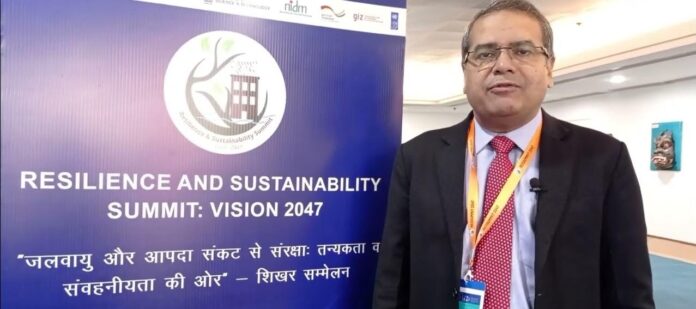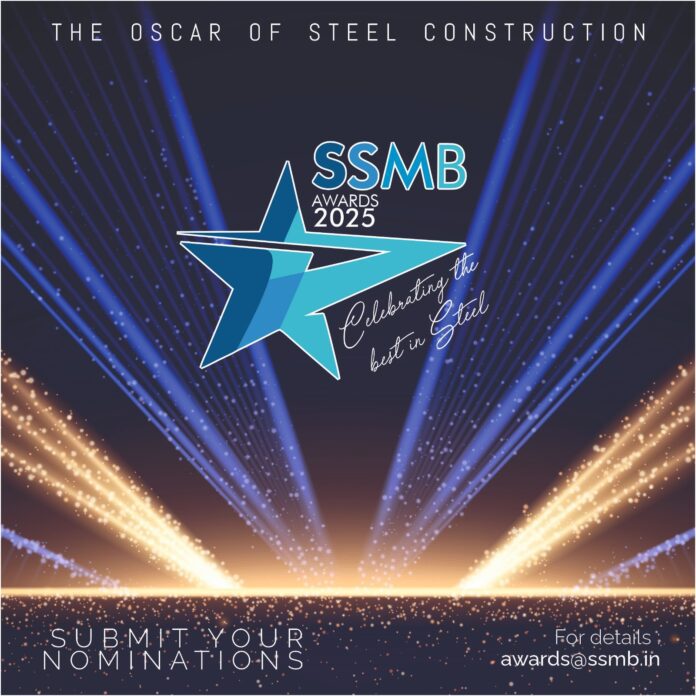Intro: Ravi Sinha is a Professor in the Department of Civil & Environmental Engineering at IIT Bombay. He specializes in steel structures, seismic design, and structural performance. His research focuses on advancing safety, resilience, and efficiency in modern steel construction. He actively collaborates with international institutions to bridge global best practices with Indian engineering standards.
Could you briefly explain the key findings from the IIT Bombay–University of California collaboration and how they might influence future Indian steel design codes?
IIT Bombay and the University of California have been collaborating extensively in recent years to study the performance of steel buildings. The research focuses on understanding how steel structures behave during earthquakes—particularly when seismic forces exceed those considered in design codes. The objective is to identify how buildings can sustain damage in the least disruptive manner and ensure that any damage is of a type that is predictable and manageable.
The team is exploring questions such as: What is the sequence of damage during an earthquake? What levels of damage are acceptable? In rare, severe earthquakes where structural failures may occur, how can buildings be designed to minimise casualties and maintain safety?
Their work aims to inform the next generation of building codes, going beyond current standards while embedding practical provisions that deliver the desired performance even under higher-than-code forces.
Interestingly, the research has revealed that steel structures in India tend to be significantly heavier than comparable buildings in the United States, even for similar occupancy loads and seismic zones. This is largely due to differences in design provisions under Indian standards. However, despite the higher material use and cost, Indian buildings do not demonstrate improved safety margins compared to their US counterparts—indicating potential areas for optimisation in design practices.
Our magazine often features technical papers that bring new insights to readers. Could you share details about any recent research or paper from your ongoing work related to steel structures?
One of our recent technical papers, developed as part of our joint research with the University of California, is scheduled to be presented at an upcoming conference in Belgium. The paper delves into the safety aspects of steel buildings—an area we have been focusing on extensively. It outlines in detail the modelling procedures, analytical methods, and behavioural studies we have conducted to assess the safety margins in steel structures.
Our findings compare the safety margins of buildings designed according to Indian standards with those designed under the American Institute of Steel Construction (AISC) standards. The study also provides quantitative comparisons, showing that Indian steel buildings typically use nearly one-third more steel than their US counterparts for similar safety levels and occupancy conditions. This additional material does not necessarily translate to higher safety but does increase cost and resource consumption. The research aims to highlight such differences and offer insights that can guide more efficient, performance-based design approaches in India.
From your perspective, what are the key technical challenges in India’s infrastructure sector that require urgent attention from the engineering community?
There are two critical challenges that need immediate focus. India today is leading the world in infrastructure development—no other country is investing and building at this scale. However, to fully realise the potential benefits of these investments, it is vital that our engineering and construction practices evolve in step with global advancements.
The first challenge lies in the slow pace of modernisation within the construction sector. Many of our design provisions, construction methods, and quality control standards have not kept up with the latest global knowledge and technological capacity. As a result, we are not achieving the maximum possible value from our infrastructure investments. If our industry practices were modernised to align with international best practices, the same investment could yield far more durable and efficient infrastructure outcomes.
The second challenge concerns maintenance and lifecycle performance. Experience shows that infrastructure projects in India often require renewed investments or major maintenance at much shorter intervals than originally projected. This points to gaps in the project design and execution cycle, which ultimately increase long-term costs and divert resources from new infrastructure development.
Both these issues—outdated industry practices and higher-than-expected maintenance demands—can be significantly mitigated by modernising the sector, strengthening quality standards, and adopting a more performance-driven approach consistent with global benchmarks.
What are some of the most common design and detailing errors you observe in Indian steel structures when it comes to ensuring seismic resilience?
Seismic resilience refers to how well a building performs during an earthquake—and this remains one of the most critical aspects of structural safety. Earthquakes generate forces that are four to five times stronger than any other loads a building experiences throughout its life. Unlike wind or occupancy loads, seismic forces can directly impact human safety, making earthquake performance a defining factor in structural design.
One major challenge is that earthquakes are rare events. Because most professionals have not personally experienced one, the importance of seemingly minor design or detailing errors is often underestimated. However, during an earthquake, even small deviations from design specifications or code provisions can lead to severe damage—and, in some cases, loss of life. Earthquakes are highly unforgiving in this respect.
Recent events, such as the devastating earthquakes along the Turkey–Syria border that claimed tens of thousands of lives within minutes, remind us of the catastrophic potential of poor seismic detailing. The lesson is clear: any compromise on design rigour or construction quality can have consequences far beyond structural damage—it can directly endanger human life.
It’s also important to recognise that such lapses rarely occur out of negligence or intent. More often, they stem from a lack of awareness or understanding of seismic behaviour among practitioners. Strengthening education, training, and enforcement of seismic design standards is therefore essential to ensure that every structure built in earthquake-prone regions meets the level of resilience needed to protect lives.
How do Indian seismic design codes for steel structures compare with international standards such as the AISC and Eurocode?
In terms of inherent safety, there is very little difference between the Indian codes and international standards like the AISC or Eurocode. For a given architectural configuration, the final design produced under any of these codes generally achieves a similar level of safety. Indian standards are well-developed—they are neither overly conservative nor unsafe.
However, our research indicates that Indian codes often lead to higher steel consumption compared to their international counterparts. This means that for the same functional and safety requirements, Indian steel structures tend to use considerably more material. The additional tonnage does not translate into higher safety margins; instead, it increases costs and resource use without any corresponding structural benefit.
There is therefore significant potential to optimise Indian design provisions—reducing steel usage while maintaining the same level of safety. Such refinements would not only make designs more efficient but also contribute to sustainability by minimising material wastage and overall project costs.
How can engineers and fabricators ensure consistent code compliance in fast-paced industrial and commercial steel projects?
The Indian steel construction industry has enormous potential for modernisation, which can significantly enhance construction speed, reliability, and quality compliance. Currently, the process is highly human resource-intensive, with many critical tasks performed on-site under variable conditions. This approach can make consistent code compliance challenging, particularly in large-scale, fast-paced projects.
A key improvement is to identify which activities are truly critical to structural performance and ensure these are executed under controlled conditions, such as in a factory environment. By shifting critical fabrication and assembly tasks from the construction site to a controlled setting, quality can be systematically monitored and assured, aligning with global best practices.
This approach not only improves compliance with codes and standards but also reduces the risk of errors and structural inconsistencies that can arise when critical work is carried out in the field. Modernising steel construction in this manner allows for faster, safer, and more reliable projects, while optimising material use and workforce efficiency.
How do you see Performance-Based Seismic Design (PBSD) shaping the future of steel structures in India?
Performance-Based Seismic Design (PBSD) goes beyond simply ensuring structural safety—it allows engineers to prescribe acceptable levels and types of damage during an earthquake. This approach enables the design to prioritise not just life safety but also functionality of critical systems.
For instance, in a hospital steel building, PBSD can ensure that essential systems such as oxygen and vacuum lines remain operational after an earthquake. This is crucial because hospitals experience a surge in demand for life-support services during seismic events. Without performance-based planning, these critical components could fail, even if the building structure meets code-defined safety levels.
PBSD allows designers to incorporate such functional requirements directly into the design framework, providing resilience tailored to the building’s purpose. However, the benefits of PBSD in India depend not only on advanced design procedures but also on modernised construction practices. If construction methods do not keep pace with the complexity of performance-based designs, the intended improvements in resilience and functionality may not be realised.
Ultimately, PBSD represents a major step forward for Indian steel structures, but its full potential can only be achieved when design sophistication is matched by high-quality, controlled construction practices.
What are your recommendations for condition assessment and structural health monitoring of large steel structures?
Condition assessment and structural health monitoring serve complementary but distinct purposes in ensuring the safety and longevity of steel structures. Condition assessment is typically a one-time evaluation to determine the current capacity and structural state. For example, when a building is 25–30 years old and undergoing renovation, a condition assessment helps identify the extent of deterioration over time. If significant damage is detected, retrofitting can be planned alongside the renovation to restore structural performance.
Structural health monitoring, on the other hand, is a continuous process. It is increasingly being adopted in India for critical infrastructure, such as metro stations, where it is mandatory. Health monitoring enables proactive intervention by detecting deterioration well before visible damage occurs. This allows action to be taken when structural performance reaches a critical threshold, even if the damage is not yet apparent to occupants.
Implementing these practices requires a shift in mindset. Traditional approaches rely on visible signs of damage to trigger repairs, whereas modern monitoring uses sensors and data analytics to identify early-stage deterioration. By detecting subtle changes, engineers can take preventive measures, improving safety and extending the life of the structure. While condition assessment is still evolving in India, structural health monitoring is gradually gaining traction, particularly in high-value and high-traffic steel structures.
Which retrofit techniques are most effective for improving the seismic performance of existing steel structures without causing major downtime?
Retrofit strategies for steel structures depend heavily on the specific characteristics of each building, so there is no universal solution. However, several approaches are commonly employed in practice. One popular method is the addition of bracing systems, which can enhance lateral stability and overall seismic resistance. Another approach is strengthening the moment-resisting frames, improving their ability to withstand earthquake-induced forces. External supporting frames can also be used to provide additional structural support without extensive internal modifications.
While these techniques are conceptually well-established, the engineering details must be tailored to each building’s layout, load conditions, and usage requirements. Not every retrofit approach is feasible for every structure, so solutions are determined on a case-by-case basis. Careful assessment and customised design ensure that the chosen method maximises seismic resilience while minimising disruption to ongoing operations.
How can India enhance technical training for structural engineers in advanced steel design and detailing?
Steel is a highly complex material, and modern steel building design and construction involve sophisticated concepts that go beyond what a typical four-year undergraduate civil engineering program can cover. While undergraduate education provides a broad foundation, it does not fully equip engineers to take sole responsibility for designing advanced steel structures.
To develop professional competence, engineers need continuous, advanced-level training throughout their careers. Exposure to practical projects, specialised workshops, and professional development programs is essential to build the depth of knowledge required for modern steel design and detailing.
The current training programs provide a solid introduction to core concepts, but true mastery comes from a combination of foundational learning and ongoing advanced training. By integrating classroom learning, hands-on experience, and continuous skill development, engineers can gain the expertise necessary to design and execute steel structures safely and efficiently.
What types of collaborative research or consultancy models between academia and industry could help accelerate innovation in the steel sector?
This is a critical area for India’s steel industry. Currently, there is a significant gap between domestic practices and global best standards, and the fact that Indian steel construction is still catching up indicates a strong need for external support.
Collaboration with academia can play a pivotal role in bridging this gap. Universities and research institutions can provide advanced technical expertise, access to the latest research, and structured experimentation capabilities that may not be feasible within industry alone. Joint research projects, consultancy partnerships, and knowledge-exchange programs can help the industry adopt innovative construction techniques, improve design efficiency, and enhance overall quality.
By forming sustained partnerships with academic institutions, the steel sector can accelerate its adoption of global best practices, improve competitiveness, and contribute to the development of more efficient and resilient steel structures in India.
“Seismic resilience is unforgiving— even the smallest lapse in design or detailing can have consequences far beyond structural damage.”
— Prof. Ravi Sinha, IIT Bombay




